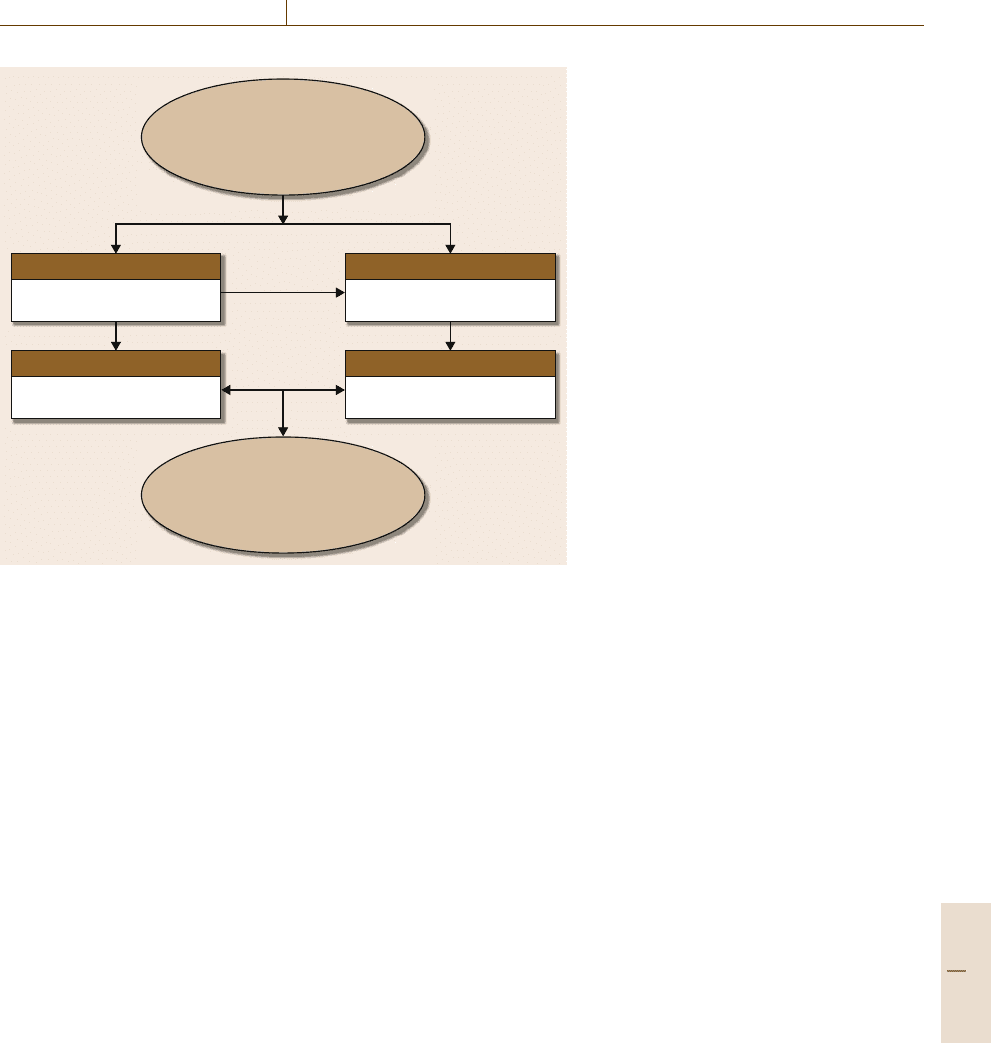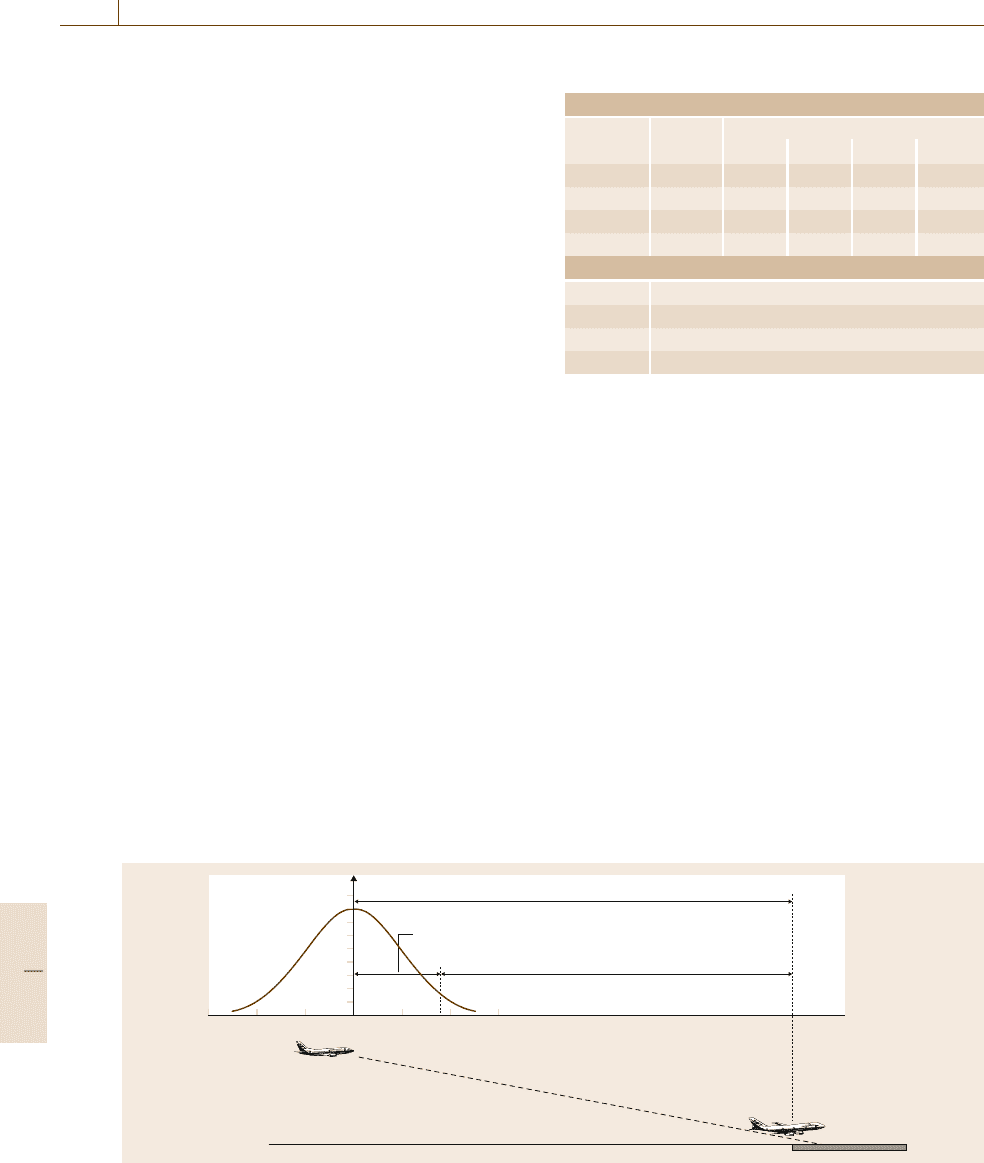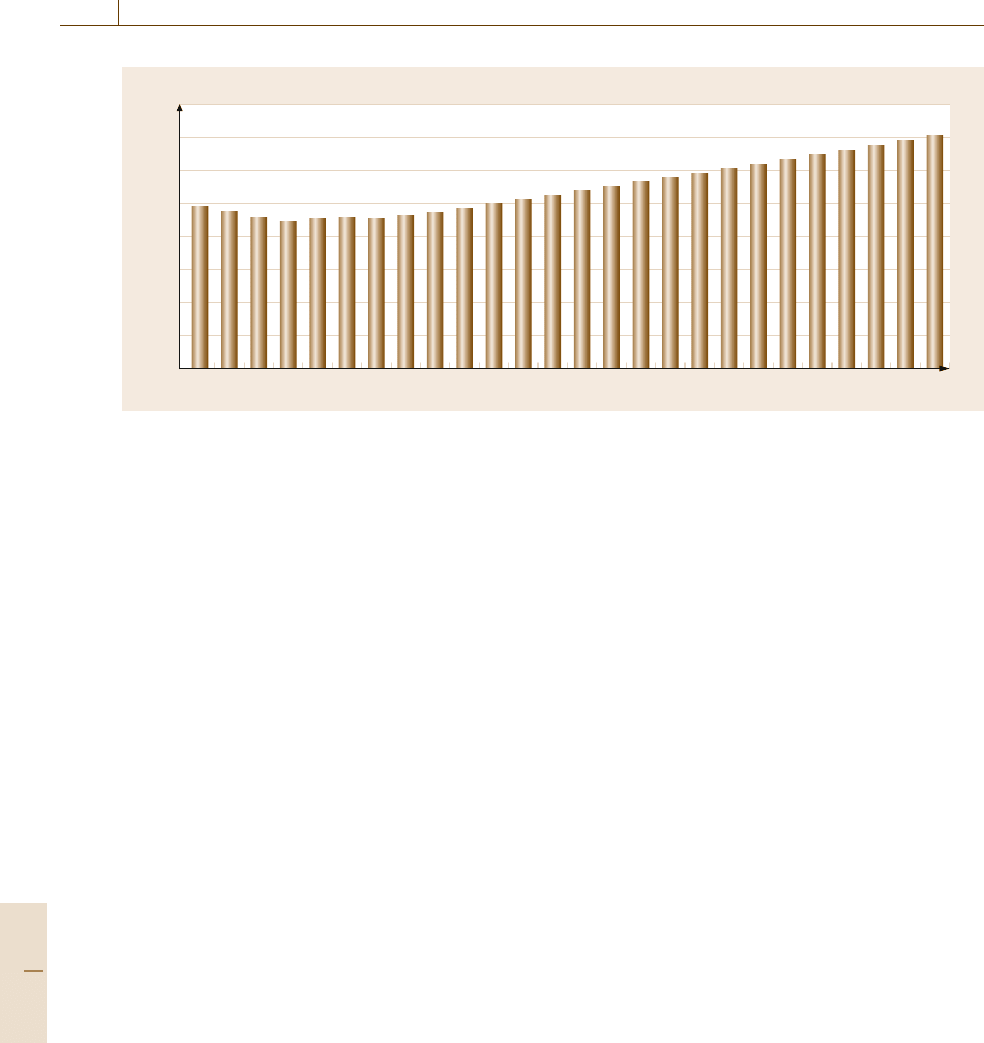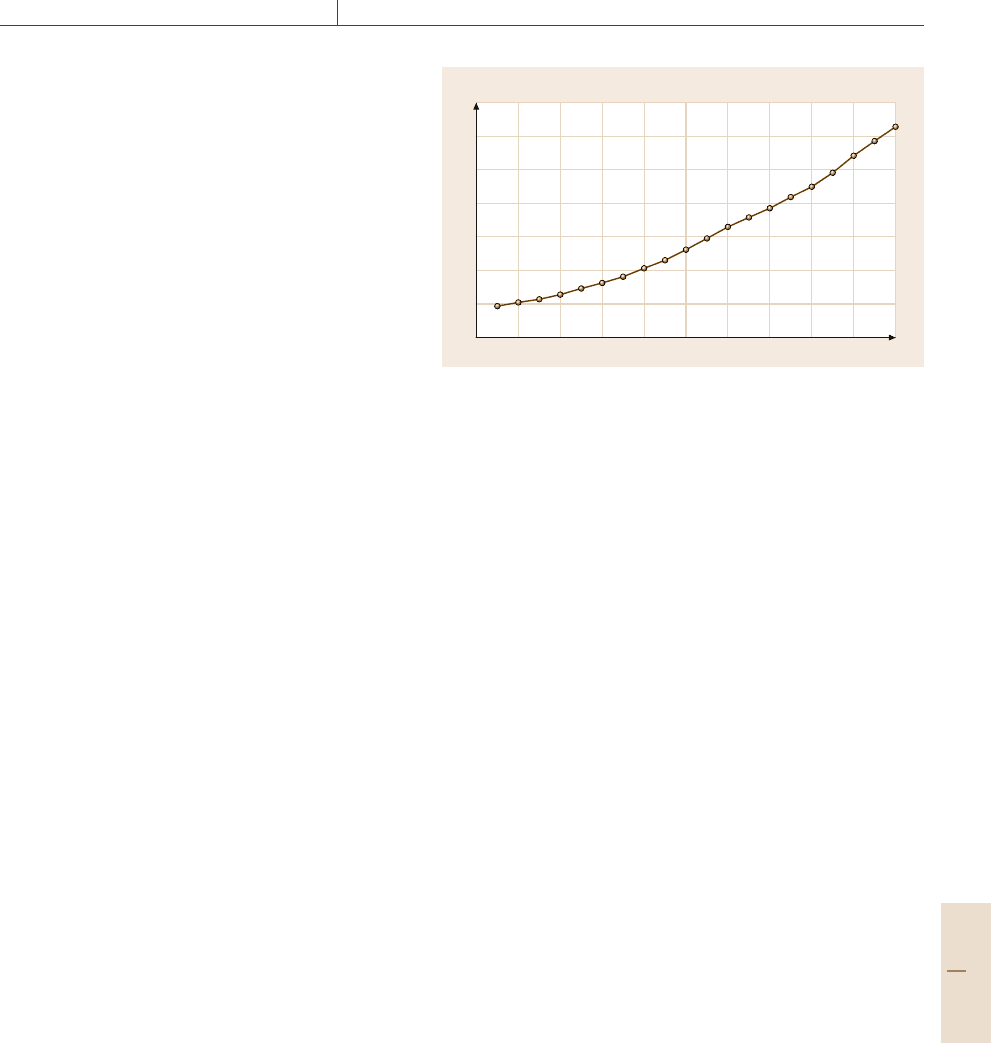Nof S.Y. Springer Handbook of Automation
Подождите немного. Документ загружается.


Air Transportation System Automation 67.3 Functional Role of Automation in the Ground System for Flight Safety and Efficiency 1195
tothrottle adjusts the throttles to achieve the desired
speed. The EFIS function of the FMC provides dynamic
and background data to the EFIS symbol generator as
well as selection of navaids.
The FMCS functions include:
•
Flight plan management: provides on board flight
planning from a global database including prede-
fined routes.
•
Guidance: by integrating precise position and on-
board flight planning information, provides three-
dimensional (3-D) navigation plus speed or four-
dimensional (4-D) navigation including 3-D and
time. Lateral guidance provides precise path con-
trol and smooth maneuvers at turning points.
Vertical guidance provides precise vertical path
control.
•
Performance management: providesoptimum speed,
altitude, and thrust settings to minimize operational
costs. A choice of economy or alternative flight
modes is also available.
The aircraft operator, for example, can select at the
outset what is most important to the airline’s bottom
line for that particular flight (operating at minimum fuel
cost, operating with minimum flight time, or a blend
between the two). The FMCS then determines the op-
timum vertical profile and speed schedule for the flight,
taking into account all known factors such as en route
winds, temperatures, and aircraft weight. The FMCS
constantly refines its output to account for any change
in actual winds or temperature. The wind field data
that provides the FMCS with information on future
waypoints is easily uplinked to the aircraft using an
air–ground data link. If the flight is not constrained by
the AT C restrictions, the flight profile dictated by the
FMCS will be the optimum. In the case when the AT C
constraints are imposed, the FMCS will still provide an
optimum profile within those constraints.
In many implementations of the modern FMS,the
management of the speed and altitude profiles effec-
tively replace the shortcomings of the non-FMS relic
of look-up performance tables and rules of thumb. The
FMCS outputs can be fed directly to the aircraft autopi-
lot/flight director system (APFDS), thereby reducing
workload for the pilot and making him/her better aware
of the progress of the flight flown by the automation
system.
67.3 Functional Role of Automation in the Ground System
for Flight Safety and Efficiency
In the ground automation system, two functions,
MSAW and CA, provide safety alerts to the controllers
in all ARTCCs and most TRACONS. The MSAW
checks aircraft tracks for current and predicted conflicts
with a terrain, and the CA checks for aircraft-to-aircraft
conflicts. Both functions alert the controllers through
display indications and audible outputs. The user re-
quest evaluation tool (URET) is an automation system
deployed in the ARTCCs to detect potential conflicts
20min in advance in order to help controllers take early
decisions to resolve aircraft-to-aircraft and aircraft-to-
airspace conflicts.
67.3.1 Minimum Safe Altitude Warning
The MSAW function is used to detect the proximity of
aircraft to a terrain or surface obstructions. It uses two
subfunctions for detecting hazards. One subfunction de-
tects the proximity of an aircraft on the final approach
for landing to the required minimum descent altitude
or the decision height for the approach. The second
subfunction is used to detect whether the aircraft is in
hazardous proximity to a terrain outside the approach
areas. Thelocation of the aircraft is compared against an
internally defined digital map containing the heights of
the highest obstructions within the defined areas. When
a hazard is detected, the automation system produces
a visual alert by displaying a flashing symbol near the
affected aircraft. The automation system also sets off an
alarm when a hazard is detected.
67.3.2 Conflict Alert
The CA function detects an imminent loss of separation
between two controlled aircraft that could lead to a po-
tential mid-air collision. It can detect conflicts both for
those aircraft that are traveling in a straight line and for
those that are executing turns in a maneuver. When an
alert is detected, the automationsystem displays a flash-
ing symbolnextto thepositions ofthe aircraftthat arein
jeopardy. The CA function also sets off an aural alarm
to warn the controller that a conflict has been detected.
Part G 67.3

1196 Part G Infrastructure and Service Automation
Potential conflicts, defined by a horizontal separa-
tion parameter and an altitude separation parameter,
are detected by projecting a volume of airspace con-
structed about each track along its velocity vector from
its present position to a position some time in the future.
En route CA function typically uses a horizontal param-
eter of 4.8nmi, an altitude of 1000ft, and a projection
time parameter of 120s. The corresponding terminal
CA function uses the horizontal parameter of 1.2nmi,
375ft vertically, and a projection time of 40 s. The
CA function considers only the aircraft tracked by the
ground automation systems with valid altitude informa-
tion. If another aircraft is found within the volume of
the projected airspace for a given subject aircraft, a po-
tential conflict is declared and an indication is given on
the displays for the sector(s) controlling the aircraft.
67.3.3 User Request Evaluation Tool
The URET [67.8] replaces flight progress strips with
electronic flight information, thereby reducing the need
to maintain and mark strips. In addition, URET notifies
the controllers of aircraft-to-aircraft separation prob-
lems and aircraft-to-special activity airspace problems.
The URET is a decision support function that com-
bines real-time flight plan and en route automation track
data with site adaptation, aircraft performance charac-
teristics, and winds and temperatures aloft to construct
four-dimensional (4-D) flight profiles, or trajectories for
both predeparture and activeflights. For thelatter, it also
adapts itself to the observed behavior of the aircraft,
dynamically adjusting predicted speeds, climb, and de-
scent rates based on the performance of the flight as it
is tracked through the en route airspace. The URET’s
predicted trajectories are used to continuously detect
potential aircraft conflicts up to 20 min into the future,
and to provide strategic notification to the appropriate
controllers. These trajectories also provide the basis for
the NAS trial flight planning capability. The trial flight
planning process allows the controllers to check if a de-
sired change in an aircraft flight plan would result in
potential conflicts with other aircraft later, before such
a change in the flight plan is approved.
67.3.4 Traffic Management Advisor
The traffic management advisor (TMA) is a deci-
sion function supported by the en route automation
in the ARTCCs to assist traffic management person-
nel and controllers in optimizing arrival traffic flows
to capacity-constrained airports. The TMA uses air-
craft trajectory models, real-time radar track data, flight
plan data, and wind data updated every 12s to compute
optimal schedule arrival times at the TRACON entry
(meter) fixes. The TMA algorithms consider IFR sep-
aration minima for the airspace and final approaches
to the runways, desired airport acceptance rates, and
other AT C constraints. They determine the delays for
the aircraft while they are still in the en route airspace
controlled by the ARTCC so that the desired airport
acceptance rates are not exceeded.
The TMA is intended to enhance the efficiency
of flight operations and increase throughput relat-
ing to airport capacity during periods of peak traffic
demand [67.9]. The aircraft-specific time delays are
displayed to the controllers. It is at the controller’s dis-
cretion to maneuver the aircraft to achieve the required
delays. The TMA is intended to help controllers land
more aircraft per unittime, and redistribute theunavoid-
able delays for aircraft from the lower (near the airport)
to higher altitudes in the ARTCCs for fuel efficiency
and reduced direct operating costs. Additionally, the
TMA is expected to reduce flight time for aircraft by re-
ducing holding and vectoring outside of the TRACON
airspace. This isachieved by coordinatingand optimally
sequencing flights to the runways arriving from differ-
ent directions.
The MSAW and the CA functions have been imple-
mented in both the en route and terminal automation
systems for a number of years. The URET and TMA
functions are being deployed, andall ARTCCs will have
them in use in the near future.
67.4 CNS/ATM Functional Limitations with Impact
on Operational Performance Measures
As stated earlier, the current CNS/ATM functions pro-
vide information to the pilots and controllers, and most
of the decisions in the aircraft and on the ground are
made open loop manually. The primary requirement is
to conduct safe flight operations by following a set of
separation rules either by maintaining a safe distance
between the aircraft or safe altitude separation. The
controllers manually trying to achieve these separations
between aircraft by relying on tracked aircraft position
and velocity information often permit larger separations
Part G 67.4

Air Transportation System Automation 67.4 CNS/ATM Functional Limitations with Impact on Operational Performance Measures 1197
Separation minima
Spacing buffers
Flight safety
• Operational deviation
• Operational errors
Airport capacity
• Wake vortex separations
Controller workload
• Task load
• Complexity
Aircraft operational efficiency
• Flight delays
• Radar separation
• Lateral separation
• Departure/arrival separation
- Single runway
- Multiple runways
Impact
• Deviating from optimum paths needed
for aircraft delays
• Additional clearances to maneuver
aircraft
Fig. 67.8 Impact of separation min-
ima on operational performance
than the required minimums by adding a safety buffer.
The use of distance separations larger than the desired
minimum reduces capacity, especially at airports. With
fewer aircraft permitted to depart and land than the sep-
aration minima would otherwise allow, delays due to
the reduced capacity add operating costs for the users.
In order to delay aircraft in the air while trying to meet
the safe separation objectives, the controllers deviate
aircraft from their desired optimum paths by issuing ad-
ditional clearances to maneuver the aircraft by changing
their paths, altitudes or speeds. Any deviations from the
desired minimum flight profiles increase workload for
both the controllers and the pilots, who have to manu-
ally fly the aircraft during these maneuvers, while the
controllers continue to monitor aircraft compliance to
the changes.
Figure 67.8 illustrates the impact of separation min-
ima on the operational performance measures relating
to flight safety, airport capacity, aircraft operational ef-
ficiency, and controller workload, which are discussed
below.
67.4.1 Current Separation Minima
for Controlled IFR Aircraft
For all controlled aircraft using IFR, the radar-tracked
position, velocity, and altitude information are used by
the controllers to keep the aircraft separated using the
separation minima rules presented in Table 67.1. The
separation requirements apply in all controlled airspace,
except during the departure and landing phasesof flight.
These are based upon the radar resolution accuracy
and update rate in the horizontal domain, and on the
accuracy of the altimeter in the vertical domain. In ad-
dition to the radar tracking capabilities, the longitudinal
or in-trail separation minima on the final approaches
also depend upon the aircraft wake turbulence. All air-
craft generate a wake, which is a disturbance caused
by a pair of counter-rotating vortices trailing from the
wing tips. The strength of these vortices depends upon
the size/weight of the leading aircraft and affects the
trailing aircraft by imposing rolling moments exceeding
the roll-control capability of the aircraft behind. Be-
cause of this wake turbulence effect, the controllers are
required to use larger separations for trailing aircraft
behind larger or heavier aircraft, including a Boeing
B-757. These rules directly impact the capacity of the
NAS [67.10,11].
Minimum Lateral Separation
between Adjacent Routes
Two aircraft navigating on different airways must have
their route centerlines separated laterally by 8 nmi
as long as the aircraft are less than 51nmi from
Part G 67.4

1198 Part G Infrastructure and Service Automation
Table 67.1 Separation minima
Flight phase Separation minima Requirements Controlling factor
En route airspace 5 nmi horizontal Below 60000ft, if multiple radar sensors (mosaic
mode) used or either aircraft is more than 40nmi
from antenna, and 60 nmi if mode S surveillance
is used
Radar resolution
accuracy and update rate
En route path width 8nmi Adjacent route separation minima Navigation mode and
system accuracy
Terminal airspace 3nmi horizontal Below 18 000 ft, if radar in single-sensor mode and
both aircraft within 40nmi of antenna
Radar resolution
accuracy and update rate
All airspace 2000ft vertical Above 29000ft Altimeter accuracy
1000ft Above 29000ft (RVSM
∗
) or all aircraft at or be-
low 29000ft
RVSM certified altimeter
above 29000ft
Successive arrivals –
Same runway or parallel run-
ways spaced < 2500 ft apart
Longitudinal:
3.0nmi
Radar in single sensor mode and both aircraft
within 40nmi of the antenna
Radar resolution
accuracy and update rate
2.5nmi On final approach, if runway occupancy time is
50s or less and no wake turbulence effect
Runway occupancy time
4/5/6nmi Behind a heavy aircraft or B757 (depends on trail-
ing aircraft type)
Wake turbulence
Parallel approaches –
Independent ILS approaches to
dual runways
Simultaneous opera-
tions once established
on final approach
Runways ≥4300ft apart
Require ASR
Blunder recovery
Runways 3400–4300 ft apart
Require final monitor aid or PRM
Radar resolution
accuracy and update rate
Runways 3000–3400 ft apart
Require PRM and 2.5
◦
localizer offset
Localizer resolution
∗∗
Parallel approaches –
Dependent ILS approaches to
dual runways
2.0nmi diagonal
between aircraft on
adjacent runways
Runways ≥4300ft apart Blunder recovery
1.5nmi diagonal
between aircraft on
adjacent runways
Runways 2500–4300 ft apart Wake turbulence is an
issue below 2500ft
runway spacing
Successive departures –
Same runway or parallel run-
ways spaced < 2500 ft apart
1.0nmi Courses diverge by 15
◦
or more (not behind
heavy/B757)
Radar separation
Wake turbulence
2.0nmi increasing to
3.0nmi
Courses do not diverge Radar separation
Wake vortex separa-
tion:
– Distance (see above)
– Time (2min)
Behind a heavy/B757 aircraft Radar separation
Wake turbulence
Simultaneous departures –
Parallel or nonintersecting
runways
Simultaneous
operations
Parallel runways separated by 2500ft or more and
courses diverge by 15
◦
or more
Radar separation
Wake turbulence
Non intersecting runways with courses diverge
15
◦
or more
Departure and arrival –
Same runway
2.0nmi increasing to
3.0nmi
Within 40nmi of the radar antenna Radar separation
Radar resolution
accuracy and update rate
2.0nmi increasing to
5.0nmi
Not within 40nmi of the radar antenna
Part G 67.4

Air Transportation System Automation 67.4 CNS/ATM Functional Limitations with Impact on Operational Performance Measures 1199
Table 67.1 (cont.)
Flight phase Separation minima Requirements Controlling factor
Departure and arrival –
Same runway
2.0nmi increasing to
3.0nmi
Within 40nmi of the radar antenna Radar separation
Radar resolution accu-
racy and update rate
2.0nmi increasing to
5.0nmi
Not within 40nmi of the radar antenna
Departure and arrival –
Parallel or nonintersecting run-
ways
Simultaneous
operations
Thresholds are even
∗∗∗
Runway thresholds are at least 2500ft apart
Missed approach and departure courses diverge by
at least 30
◦
Missed approach by a heavy jet cannot overtake
departing aircraft
Radar separation
Wake turbulence
∗
Aircraft equipped with required vertical separation minimum (RVSM) certified altimeter;
∗∗
RNAV/RNP arrivals may reduce lateral deviations and enable arrivals to runway with separation less than 3400ft without the need
to offset one of the approaches;
∗∗∗
Staggered thresholds increase or decrease the runway separation required
a VOR/DME station. When the aircraft are more than
51nmi from the navaid, the airways should diverge at
anangleof4.5
◦
from the navaid. If both aircraft are fly-
ing in RNAV mode, a constant 8nmi lateral separation
could be maintained.
67.4.2 Flight Safety Assessment Metrics
In spite of millions of operations over the years, there
have been an insignificant number (1198 from 1959 to
2006) of passenger aircraft accidents [67.12] as a result
of controllers enforcing the above separation minima.
US and Canadian operators were involved in only
one-third of these accidents. However, due to system
inaccuracies and human judgment, aircraft sometimes
come closer to each other than the established sep-
aration minima. In order to minimize the number of
separation violations, the controllers add an extra buffer
to the desired separation, especially during the land-
ing phase of flight where wake turbulence could be
critical to aircraft safety. Even with the increased sep-
aration between aircraft due to the added buffer, there
are still flights that occasionally end up with less than
the desired minimum separations. In order to assess
and analyze the causes of reduced separations, the
following two performance measures are determined
from the recorded operational data or controller/pilot
reports [67.13]:
•
Operational errors: an occurrence attributable to an
element of the AT C system in which less than the
applicable separation minima results between two
or more aircraft, or between an aircraft and the
terrain or obstacles (e.g., operations below the min-
imum vectoring altitude, equipment/personnel on
runways, or aircraft lands or departs on a runway
closed to operations after receiving air traffic autho-
rization)
•
Operational deviations: an occurrence attributable
to an element of the ATC system in which the appli-
cable separation minima, as referenced above, in the
operational error were maintained, but the aircraft
penetrated the airspace that wasdelegatedto another
airspace sector or facility without prior coordination
and approval; or an aircraft, vehicle, equipment, or
personnel encroached upon a landing area that was
delegated to another position of operation without
prior coordination or approval.
The ATC system continues to work on mitigating the
causes of the above errors and deviations.
67.4.3 Determination of Airport Capacity
Even though the traveling public is the ultimate user
of the NAS resources, from an operational perspective,
what matters most is the actual number of flight op-
erations that the CNS/AT M system is able to handle
without delays. The separation rules no doubt are in-
tended to ensure safety, but they also directly relate to
airport capacity. These separationrequirements limitthe
number of operations when the traffic demand is heavy.
Often airspace congestion is caused by traffic demand
exceedingthe airportcapacity. Consequently, maximum
utilization of airport capacity is paramount to keeping
the flight delays to a minimum. The allowable opera-
tions at an airport depend upon a number of separate el-
ements including the surrounding airspace, the runways
Part G 67.4

1200 Part G Infrastructure and Service Automation
and taxiways, the gates and parking apron, and the ter-
minal building (including ticket counters, securitygates,
and baggage claim areas). Any one of these elements
could limit the number of passengers that can be ac-
commodated per unit time (hourly, daily) at an airport.
The airport capacity is defined as the maximum
sustainable runway throughput of aircraft arrivals and
departures on a long-term basis, given continuous sus-
tained traffic demand. Although the actual throughput
may be different in a given hour, due to short-run
variations in aircraft mix, control procedures, etc.,
the measure of theoretical capacity is relevant for
comparison of operational performance at airports,
or developmental alternatives to enhance capacity at
a given airport. The following factors are part of the
airport capacity estimation process [67.14]:
•
Aircraft characteristics:
– Final approach speed
– Runway occupancy time (ROT) – mean and
standard deviation (the ROT for arrivals is the
average time interval from the time an aircraft
crosses the runway threshold to the time when it
exits the runway)
•
Aircraft fleet mix (percentage of different aircraft
types and/or weight classes)
•
Separation minima (as discussed in Table 67.1):
– Minimum arrival separations (arrival–arrival)
– Minimum arrival/departure separation for the
shared runway
– Minimum departure separations (departure–
departure)
– Minimum interarrival separation (minimum re-
quired separation distance plus a performance
buffer for safety)
Safe interarrival separation
Performance spacing puffer
Required minimum separation (by weight class)
Trailing aircraft
Lead aircraft
95%
Fig. 67.9 Interarrival time determination
Table 67.2 Wake vortex interarrival separation (nmi)
Arr–Arr separations at threshold
Leading aircraft type
Heavy B757 Large Small
Trailing Heavy 4 4 2.5 2.5
aircraft B757 5 4 2.5 2.5
type Large 5 4 2.5 2.5
Small 6 5 4 2.5
Aircraft weight classes
Heavy Maximum takeoff weight > 255000lb
B757 Boeing 757
Large 41 000–255000lb
Small ≤ 41000lb
•
Relative percentage mix of arrivals and departures,
or an arrival/departure ratio, for a given time period
•
Performance spacing buffer.
As mentioned earlier, a buffer is added for safety
to the required minimum separation distance between
successive arrivals. This buffer reflects the variations
in aircraft performance, as well as the manual control
process for turning aircraft for the final approach. The
buffer was estimated based on datacollected in the USA
in the 1970s, but is still used in estimating capacity for
the airports. This buffer was determined to be a nor-
mally distributed interarrival error of 18s (1σ) to reflect
the spacing error at the threshold [67.14]. The mean in-
terarrival separation is assumed to be 1.65σ above the
minimum desired separations. This 5% approximation
is a modeling construct only to account for a num-
ber of factors primarily relating to speed variability. It
does not imply that 5% of the actual aircraft pairs in-
Part G 67.4

Air Transportation System Automation 67.4 CNS/ATM Functional Limitations with Impact on Operational Performance Measures 1201
trail lack minimum desired separation. Although it is
possible that theactual interarrival spacingcould be rep-
resented byother distributions, the FAA airport capacity
model hasalways useda normal distribution.The model
is intended to provide an estimate of airport capacity
for relative comparison purposes. It is not intended to
estimate an actual controller’s ability to achieve a cer-
tain level of arrival throughput. Table 67.2 shows the
required separation minima between successive arrivals
based on the wake vortex considerations for different
weight classes of aircraft. Figure 67.9 shows the delin-
eation of interarrival time (IAT)givenby
IAT =
Desired minimum separation+1.65σ
Final approach speed of trailing aircraft
.
(67.3)
Airport Capacity for Arrival Operations
on a Single Runway
The arrival capacity [67.15] is computed by determin-
ing the average time between successive arrivals, and
inverting this time to find the maximum number of ar-
rivals per hour
Capacity
=
3600
Average time separation between arrivals
=
3600
TAA
.
(67.4)
The required time separation for each aircraft class
pair (
TAA(i, j)) is determined by comparing the arrival
runway occupancy time of the lead aircraft i and the
IAT over the runway threshold for the aircraft pair ij,
and selecting the larger of these two values. The fre-
quency with which each aircraft class pair would occur
is assumed to be the product of their individual frequen-
cies, e.g., the frequency of occurrence of the class pair
i, j =%i ×%j/10000. Therefore, the average time sep-
aration between arrival pairs is computed as the sum
over all class pairs of the product of
TAA(i, j)andthe
frequency with which the pair is expected to occur
TAA =
i, j
TAA(i, j)×%i ×%j/10000 . (67.5)
In determining the arrival runway occupancy time
and the landing time between arrivals, the airport capac-
ity estimation process used is an airport capacity model
(ACM) that considers the variability of aircraft, pilots,
and controllers, as expressed by the standard deviations
of arrival runway occupancy time and arrival–arrival
time separation. In addition, to determine the time be-
tween arrivals over the runway threshold, the ACM
considers the final approach velocities of the aircraft
pair and the length of the common final approach path.
If the velocity of the trailing aircraft is less than the
velocity of the lead aircraft, the specified minimum
arrival–arrival separation is considered at the merge
point of the two approach paths.
Airport Capacity for Departure Operations
on a Single Runway
The capacity of a departure-only runway is given by
Capacity
=
3600
Average time separation between departures
=
3600
TDD
.
(67.6)
The required time separation for each aircraft class
pair (
TDD(k, l)) is determined by comparing the depar-
ture runway occupancy time of the lead aircraft k and
the time separation between departures (from the run-
way threshold) for the aircraft pair kl. The larger of
these two values is assumed to be the required time sep-
aration at the runway threshold for this pair of departure
aircraft classes. The average time separation between
departures is computed as the sum over all class pairs
of the product of
TDD(k, l) for each aircraft class pair
and the frequency with which the aircraft class pair is
expected to occur
TDD =
i, j
TDD(k, l)×%k ×%l/10000 . (67.7)
Airport Capacity for Mixed Arrival/Departure
Operations on a Single Runway
To insert departures between arrival pairs, the airport
capacity model imposes the following requirements:
•
The departures cannot roll if an arrival is already on
the runway
•
The departures cannot roll if:
– An arrival is within some specified distance of
the runway threshold, or
– The departure cannot clear the runway before
the arrival comes over the threshold.
•
The departure–departure separation minima must
also be met to insert multiple departures between an
arrival pair.
By employing theseconditions, themodel computes
the probability of inserting one, two, or three departures
between each arrival pair. The interleaved departure ca-
pacity is then determined from these probabilities and
the aircraft mix.
Part G 67.4

1202 Part G Infrastructure and Service Automation
IFR operations (millions)
40
35
30
25
20
15
10
5
0
2000
2001
2002
2003
2004
2005E
2006
2007
2008
2009
2010
2011
2012
2013
2014
2015
2016
2017
2018
2019
2020
2021
2022
2023
2024
2025
Fig. 67.10 Annual controlled aircraft operations
Airport Capacity for Dependent Arrivals
and Departures on Two Runways
The model can also compute the capacity for a pair of
runways when departures on one runway are dependent
on the arrivals to the other runway. The departures can-
not be released if an arrival is within a specifieddistance
from the runway threshold, but can be released as soon
as the arrival touches down. It is not necessary to wait
until the arrival has exited the runway.
The logic for computing the departure capacity of
this configuration is similar to that used for a single
runway. After the interarrival times are obtained, the
probability of performing one, two, or three departures
in each interarrival gap is calculated. The departure–
departure separation minima are enforced, not just
between the departures in the same interarrival gap,
but also between the departures in the adjacent gaps.
This is rarely necessary for mixed aircraft operations
on a single runway, because the time required for an
arrival operation is usually greater than the departure–
departure separation minima.
67.4.4 Aircraft Delays
to Measure Operational Efficiency
Ideally all aircraft operators would like to fly the most
wind-favored airway or a direct route if they are RNAV
equipped, from the origination airport to the destination
airport. This is generally feasible during light traffic pe-
riods when the airports are not operating at capacity.
During medium to heavy periods of traffic demand, the
airport capacity limits the number of departures and ar-
rivals, which result in delays. As shown in Fig.67.10,
the number of annual controlled IFR aircraft operations
(including air carrier, commuters, air taxi, and high-end
general aviation aircraft) is expected togrowfrom a cur-
rent 23 to 35million by the year 2025. Unless means
are explored to increase capacity, especially at the ma-
jor airports, delays will continue to increase, thereby
impacting the aircraft operational efficiency that will
significantly increase the users’ direct operating costs.
Fig.67.11 shows the increase in average delays per air-
craft in the NAS at 35 major airports. As shown in the
figure, the average delay perflight will increase from the
current 10 to 63min by the year 2025, almost six times,
as demand continues to grow, if the NAS continues
to operate as it does today. This will have an unac-
ceptable economic impact on the airlines, which may
find it almost impossible to run the operations needed
to meet the demand. Consequently, it becomes imper-
ative for government service providers to find ways
to enhance airport capacity without compromising on
safety.
67.4.5 Measuring Controller Workload
The primary role of a controller is to process a signifi-
cant amount of information and make timely decisions
to maintain safe and efficient flow of traffic. This in-
volves acquiring traffic information by continuously
monitoring traffic, perceiving potential separation vio-
lation problems, and deciding when and how to resolve
these problems. In order to perform these functions,
the controllers are involved in a number of tasks: mon-
itoring traffic situations on radar displays, entering
data through a keyboard, conducting mental assessment
Part G 67.4

Air Transportation System Automation 67.5 Future Air Transportation System Requirements and Functional Automation 1203
of potential conflicts, communicating with other con-
trollers/facility people, and communicating clearances
(routine and conflict resolution) with the pilots. Thus,
a human response to these number of tasks is used to
measure workload [67.16], which has both physical and
mental components. Perceiving and resolving potential
aircraft conflicts,especially during heavy traffic, require
more cognitive resources than handling other routine
tasks.
The workload (mental) primarily depends upon the
time interval between detecting a separation violation
and dealing with it. The earlier a decision is made to re-
solve the conflict, the less the workload for a controller.
In congested airspace, especially where the aircraft are
continually maneuvering (climbing, descending, turn-
ing, and changing speed), the controller workload is not
only affected by the number of aircraft under control,
but also by the impact of their changing geometrics,
which creates complexity [67.17]. The complexity not
only depends upon the level of peak traffic, but also
upon the specific traffic situations, e.g., the number
of aircraft on independent, converging or intersecting
paths in horizontal and vertical domains. Rightly per-
ceiving problems resulting from complexity requires
timely detectionand resolution of these problems, in ad-
2005 2007 2009 2011 2013 2015 2017 2019 2021 2023 2025
Average delay per flight (min)
70
60
50
40
30
20
10
0
Fig. 67.11 Operational delays impacting flight efficiency
dition to communicating the resolutionclearances to the
pilots. This often turns out to be a very stressful pro-
cess that has a major impact on the workload of the
controllers.
In the future, it is envisioned that automation will
accurately detect, resolve, and communicate actions
directly to the aircraft over a data link (rather than cur-
rently by voice) in order to significantly reduce the
controller workload, as traffic continues to grow.
67.5 Future Air Transportation System Requirements
and Functional Automation
In November 2005, the European Consortium of Mem-
ber States signed to define the vision and goals of the
Single European Sky ATM research (SESAR), and to
develop, validate, and implement SESAR concepts to
meet air traffic demand beyond year 2020. The US
108th Congress and the President mandated the de-
sign and deployment of an air transportation system to
meet the nation’s needs in 2025 by passing and signing
into law Vision 100 – Century of Aviation Reautho-
rization Act (Public Law 108-176). The transformed
air transportation system should be responsive to the
social, economic, political, and technological changes,
and should meet the futureneeds for safety, capacity, ef-
ficiency, and security. The legislation established a joint
planning and development office (JPDO), which is sup-
ported by the Department of Transportation (DOT), the
FAA, the Department of Defense (DoD), the Depart-
ment of Commerce (DOC), the National Aeronautics
and Space Administration (NASA), the Department of
Homeland Security (DHS), and the Office of Science
and Technology Policy (OSTP) in the White House.
The JPDO published the next-generation (NextGen)
air transportation system integrated plan [67.18]defin-
ing the objectives for the 2025 air transportation
system. The following objectives relate to the spe-
cific requirements for safety, capacity, and operational
efficiency:
•
Maintain the aviation record of safety as the safest
mode of transportation
•
Improve the level of safety as demand continues to
grow
•
Enhance airport capacity to satisfy future growth in
demand up to three times the current level
•
Minimize the impact of weather and other traffic
disruptions on NAS operations
•
Reduce the transit time from domestic curb-to-curb
by 30%.
Part G 67.5

1204 Part G Infrastructure and Service Automation
67.5.1 Automation Approach
to Meet Future Air Transportation
System Requirements
Increased level of automation in the aircraft and in the
ground system will help to meet the above stated re-
quirements for the NextGen air transportation system.
In order to improve safety, enhanced aircraft situational
awareness in the cockpit and in the ground system will
be needed to minimize operational deviations and er-
rors. To maximize capacity and flight efficiency, the
future airspace design will have to support each air-
craft filing its own desired 4-D flight plans including
route, altitudes, and expected times at key waypoints,
while the ground automation system will ascertain that
these flight plans are conflict free. This would require
the ground automation system to accurately estimate
aircraft trajectories correlated in space and time, and
precisely predict conflicts in order to negotiate any
change in theirflight plans withthe users. Ground-based
conflict-free flight planning, with the aircraft adher-
ing to the agreed trajectories, will reduce the need for
tactical controller intervention, which would minimize
workload. As such, future research should concentrate
on developing means to automate the air/ground func-
tions to enhance safety and capacity while reducing
flight delays and workload. In order to achieve this, an
automation approach is as follows.
Safety
The automation predicts aircraft conflict problems and
provides decision support to the controllers in resolving
them.
Capacity
No doubt the building of new runways and airports
increases airport capacity, but it is a time-consuming
process to address the environmental and adjoining
community issues required to add new runways to
the major airports or build new airports. Although
the airports authorities in the US are considering the
construction of a few new runways, and a couple of
new airports outside Chicago and Las Vegas, the ma-
jority of future capacity improvements will have to
come from using new technologies and automation
by:
•
Reducing separation minima, including route
widths
•
Reducing performance spacing buffers
•
Developing automated RNP approaches.
Flight Efficiency and Delays
•
Automation supports departure/arrival planning
•
For strategic end-to-end flight planning, automation
deals with system uncertainties.
Workload
•
Automation handles routine ground/air clearances
•
Transfer some ground-based decisions to the air-
craft with automation assisting aircraft in self-
sequencing, merging, and spacing.
67.5.2 Development of Automated
Functional Capabilities
Relying on automation decision support and new tech-
nologies, the following functional capabilities are going
through exploratory research and potential development
to meet the above requirements for the future air trans-
portation system.
Automated Problem Resolution
to Enhance Safety
As discussed earlier, the URET function in the ground
system provides the en route controllers with an
automated conflict detection capability, which uses
predicted aircraft trajectories to continuously detect po-
tential aircraft separation problems up to 20min into the
future, and accordingly alert the appropriate controllers.
This function is being enhanced so that the ground
automation provides the controller with solutions or
resolutions of aircraft conflicts with other aircraft, seg-
ments of airspace, and hazardous weather cells. The
MITRE Corp. center for advanced aviation system de-
velopment (CAASD) is developing such a capability,
called problem analysis resolution and ranking (PARR).
When the URET detects a conflict, the PARR examines
strategic vertical, lateral, and speed change options to
resolve these conflicts.
The PARR may be initiated for a specific aircraft
with one or more problems, or for a specific problem. In
these cases, the PARR examines a variety of resolution
dimensions and directions.If initiatedfor an aircraft, the
PARR generates resolutions which maneuver only that
aircraft. If initiated for an aircraft-to-aircraft problem,
the resolutions for each of the two involved aircraft are
generated.
For a given aircraft to be maneuvered, the PARR
searches for problem-free trajectories to resolve all
problems with that aircraft (within URET’s 20 min
Part G 67.5
